Advanced Financial Accounting - Share Option Analysis Report
VerifiedAdded on 2023/01/19
|8
|1575
|75
Report
AI Summary
This report, addressed to the Board of Directors of Foxton Ltd, provides a comprehensive overview of share options, their features, and accounting treatment under AASB 9 Financial Instruments. It defines options, detailing the rights and obligations of option holders and writers, along with the concepts of call and put options. The report explains the classification, recognition, and measurement criteria for financial assets and liabilities, including the contractual cash flow test and business model test. Practical examples illustrate how options can be used to manage investment risk and provide insights into the settlement of option contracts through cash or physical delivery. Additionally, the report includes a reflection on the challenges faced in understanding the subject matter and highlights the benefits of using options for hedging risk. The reference section provides a list of sources used for the report.

Advanced financial accounting
Paraphrase This Document
Need a fresh take? Get an instant paraphrase of this document with our AI Paraphraser
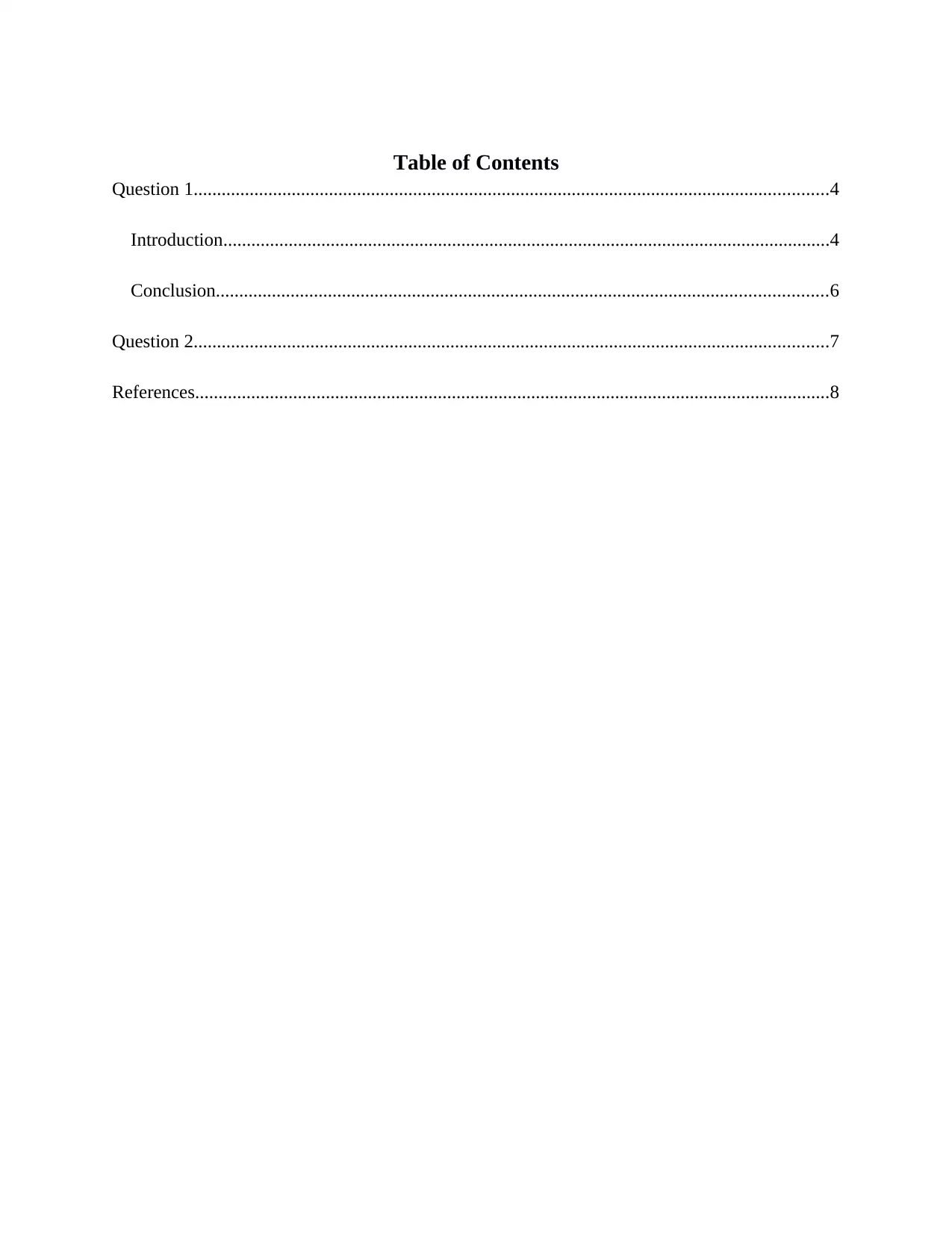
Table of Contents
Question 1........................................................................................................................................4
Introduction..................................................................................................................................4
Conclusion...................................................................................................................................6
Question 2........................................................................................................................................7
References........................................................................................................................................8
Question 1........................................................................................................................................4
Introduction..................................................................................................................................4
Conclusion...................................................................................................................................6
Question 2........................................................................................................................................7
References........................................................................................................................................8
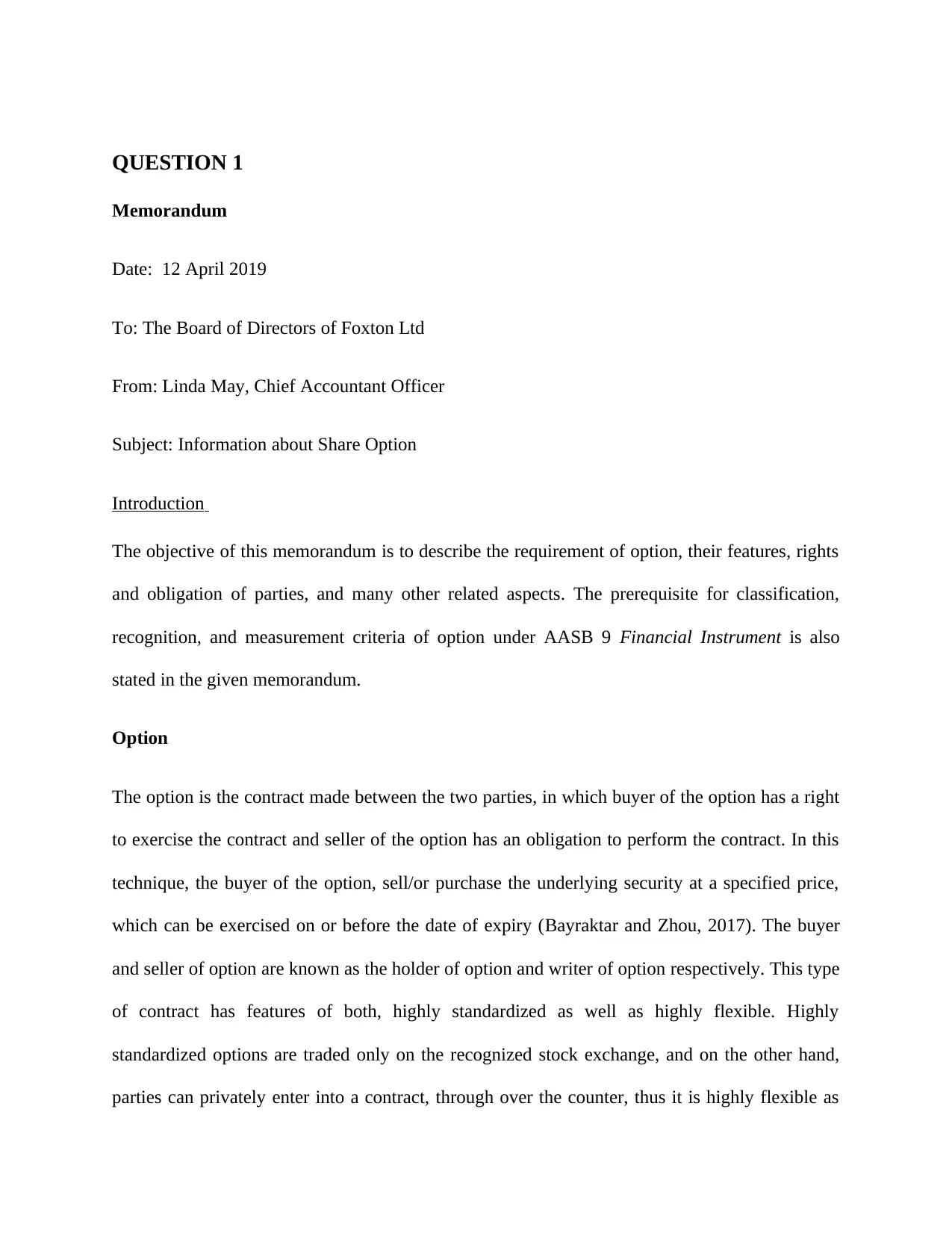
QUESTION 1
Memorandum
Date: 12 April 2019
To: The Board of Directors of Foxton Ltd
From: Linda May, Chief Accountant Officer
Subject: Information about Share Option
Introduction
The objective of this memorandum is to describe the requirement of option, their features, rights
and obligation of parties, and many other related aspects. The prerequisite for classification,
recognition, and measurement criteria of option under AASB 9 Financial Instrument is also
stated in the given memorandum.
Option
The option is the contract made between the two parties, in which buyer of the option has a right
to exercise the contract and seller of the option has an obligation to perform the contract. In this
technique, the buyer of the option, sell/or purchase the underlying security at a specified price,
which can be exercised on or before the date of expiry (Bayraktar and Zhou, 2017). The buyer
and seller of option are known as the holder of option and writer of option respectively. This type
of contract has features of both, highly standardized as well as highly flexible. Highly
standardized options are traded only on the recognized stock exchange, and on the other hand,
parties can privately enter into a contract, through over the counter, thus it is highly flexible as
Memorandum
Date: 12 April 2019
To: The Board of Directors of Foxton Ltd
From: Linda May, Chief Accountant Officer
Subject: Information about Share Option
Introduction
The objective of this memorandum is to describe the requirement of option, their features, rights
and obligation of parties, and many other related aspects. The prerequisite for classification,
recognition, and measurement criteria of option under AASB 9 Financial Instrument is also
stated in the given memorandum.
Option
The option is the contract made between the two parties, in which buyer of the option has a right
to exercise the contract and seller of the option has an obligation to perform the contract. In this
technique, the buyer of the option, sell/or purchase the underlying security at a specified price,
which can be exercised on or before the date of expiry (Bayraktar and Zhou, 2017). The buyer
and seller of option are known as the holder of option and writer of option respectively. This type
of contract has features of both, highly standardized as well as highly flexible. Highly
standardized options are traded only on the recognized stock exchange, and on the other hand,
parties can privately enter into a contract, through over the counter, thus it is highly flexible as
⊘ This is a preview!⊘
Do you want full access?
Subscribe today to unlock all pages.

Trusted by 1+ million students worldwide
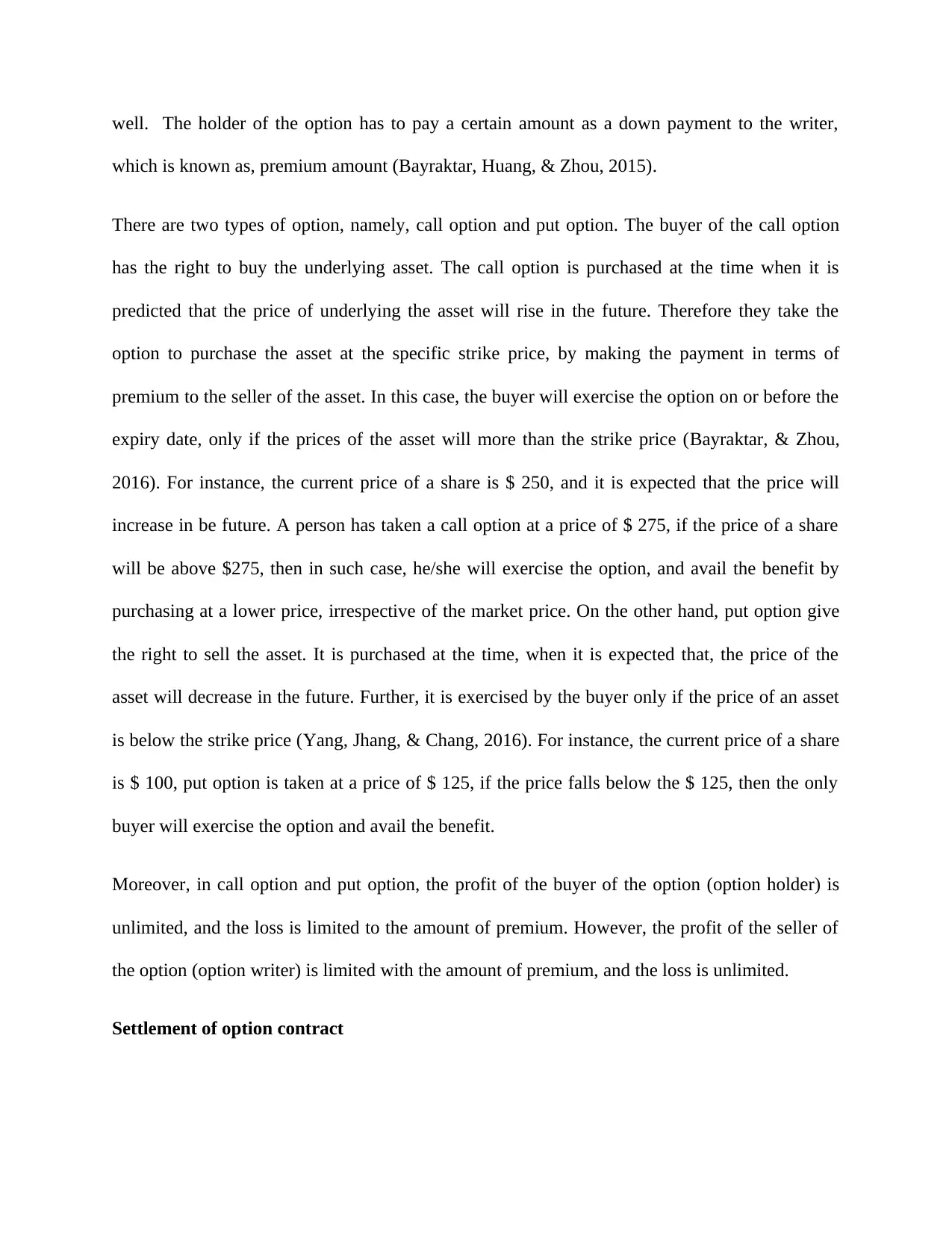
well. The holder of the option has to pay a certain amount as a down payment to the writer,
which is known as, premium amount (Bayraktar, Huang, & Zhou, 2015).
There are two types of option, namely, call option and put option. The buyer of the call option
has the right to buy the underlying asset. The call option is purchased at the time when it is
predicted that the price of underlying the asset will rise in the future. Therefore they take the
option to purchase the asset at the specific strike price, by making the payment in terms of
premium to the seller of the asset. In this case, the buyer will exercise the option on or before the
expiry date, only if the prices of the asset will more than the strike price (Bayraktar, & Zhou,
2016). For instance, the current price of a share is $ 250, and it is expected that the price will
increase in be future. A person has taken a call option at a price of $ 275, if the price of a share
will be above $275, then in such case, he/she will exercise the option, and avail the benefit by
purchasing at a lower price, irrespective of the market price. On the other hand, put option give
the right to sell the asset. It is purchased at the time, when it is expected that, the price of the
asset will decrease in the future. Further, it is exercised by the buyer only if the price of an asset
is below the strike price (Yang, Jhang, & Chang, 2016). For instance, the current price of a share
is $ 100, put option is taken at a price of $ 125, if the price falls below the $ 125, then the only
buyer will exercise the option and avail the benefit.
Moreover, in call option and put option, the profit of the buyer of the option (option holder) is
unlimited, and the loss is limited to the amount of premium. However, the profit of the seller of
the option (option writer) is limited with the amount of premium, and the loss is unlimited.
Settlement of option contract
which is known as, premium amount (Bayraktar, Huang, & Zhou, 2015).
There are two types of option, namely, call option and put option. The buyer of the call option
has the right to buy the underlying asset. The call option is purchased at the time when it is
predicted that the price of underlying the asset will rise in the future. Therefore they take the
option to purchase the asset at the specific strike price, by making the payment in terms of
premium to the seller of the asset. In this case, the buyer will exercise the option on or before the
expiry date, only if the prices of the asset will more than the strike price (Bayraktar, & Zhou,
2016). For instance, the current price of a share is $ 250, and it is expected that the price will
increase in be future. A person has taken a call option at a price of $ 275, if the price of a share
will be above $275, then in such case, he/she will exercise the option, and avail the benefit by
purchasing at a lower price, irrespective of the market price. On the other hand, put option give
the right to sell the asset. It is purchased at the time, when it is expected that, the price of the
asset will decrease in the future. Further, it is exercised by the buyer only if the price of an asset
is below the strike price (Yang, Jhang, & Chang, 2016). For instance, the current price of a share
is $ 100, put option is taken at a price of $ 125, if the price falls below the $ 125, then the only
buyer will exercise the option and avail the benefit.
Moreover, in call option and put option, the profit of the buyer of the option (option holder) is
unlimited, and the loss is limited to the amount of premium. However, the profit of the seller of
the option (option writer) is limited with the amount of premium, and the loss is unlimited.
Settlement of option contract
Paraphrase This Document
Need a fresh take? Get an instant paraphrase of this document with our AI Paraphraser

Generally, the contract ended either by the exercising the option by the option holder or at the
expiry date of the contract, whichever is earlier. The contract can be settled either through the
cash or by delivery of the underlying asset. In case of a cash settlement, the seller of the option
does not actually deliver the underlying asset, but instead the contract is settled in cash. (Roux,
2016). This method of settlement saves the money and time to deliver on expiration. On the other
hand, in case of physical delivery of settlement, the seller makes/take the delivery of an
underlying asset at the time of settlement of the contract (Jin, Shan, & Taylor, 2015).
Classification, recognition, and measurement as per AASB 9 financial instruments
As per the standard, the initial recognition of the financial asset/ financial liability is measured at
its fair value and plus/minus, a financial asset not at fair value through profit or loss, transaction
cost that is directly connected to the purchase of the financial assets. The classification of the
financial asset is based on two tests, such as contractual cash flow test and business model test
(Taušer, & Čajka, 2016). If the asset fulfils the requirement of both tests, then it is measured at
fair value with all changes in fair value reporting in profit and loss account. Further, the
classification and subsequent measurement of is based on contractual cash flow characteristics
test, if the conditional fair value of the option is selected, and this test is satisfied, then it is
measured at fair value through profit or loss account (Davari‐Ardakani, Aminnayeri, & Seifi,
2016).
Conclusion
By taking the stock option, a person can insure themselves against the investment risk. There are
two parties involved, such as option holder and option writer. The option holder has right;
whether to exercise the option or not, instead the writer has an obligation to perform the contract.
expiry date of the contract, whichever is earlier. The contract can be settled either through the
cash or by delivery of the underlying asset. In case of a cash settlement, the seller of the option
does not actually deliver the underlying asset, but instead the contract is settled in cash. (Roux,
2016). This method of settlement saves the money and time to deliver on expiration. On the other
hand, in case of physical delivery of settlement, the seller makes/take the delivery of an
underlying asset at the time of settlement of the contract (Jin, Shan, & Taylor, 2015).
Classification, recognition, and measurement as per AASB 9 financial instruments
As per the standard, the initial recognition of the financial asset/ financial liability is measured at
its fair value and plus/minus, a financial asset not at fair value through profit or loss, transaction
cost that is directly connected to the purchase of the financial assets. The classification of the
financial asset is based on two tests, such as contractual cash flow test and business model test
(Taušer, & Čajka, 2016). If the asset fulfils the requirement of both tests, then it is measured at
fair value with all changes in fair value reporting in profit and loss account. Further, the
classification and subsequent measurement of is based on contractual cash flow characteristics
test, if the conditional fair value of the option is selected, and this test is satisfied, then it is
measured at fair value through profit or loss account (Davari‐Ardakani, Aminnayeri, & Seifi,
2016).
Conclusion
By taking the stock option, a person can insure themselves against the investment risk. There are
two parties involved, such as option holder and option writer. The option holder has right;
whether to exercise the option or not, instead the writer has an obligation to perform the contract.

The recognition and measurement are based on fair value, including any direct cost connected
with the asset.
QUESTION 2
The most difficult or challenging fact about responding to the answer was the recognition and
subsequent measurement criteria of the option. Further, I provided an appropriate explanation
regarding the call option and put option, along with the conditions in which it will be exercised. I
explained this, by giving the practical, numerical example, which can be easily understood by
anyone and can ascertain about the manner in which investment risk can be mitigated. Overall, I
explained all the aspect in a very well manner. However, the least explained by me is the
contractual cash flow test and business model test. By responding the question one, I learned that
option is considered as a very beneficial tool for hedging the risk against the currency
fluctuation. I observed that the option holder has the right to execute the contract; it is not
mandatory. There is a possibility to earn an unlimited profit, and the maximum loss in this
technique is the amount of premium paid by the buyer to seller of the option.
with the asset.
QUESTION 2
The most difficult or challenging fact about responding to the answer was the recognition and
subsequent measurement criteria of the option. Further, I provided an appropriate explanation
regarding the call option and put option, along with the conditions in which it will be exercised. I
explained this, by giving the practical, numerical example, which can be easily understood by
anyone and can ascertain about the manner in which investment risk can be mitigated. Overall, I
explained all the aspect in a very well manner. However, the least explained by me is the
contractual cash flow test and business model test. By responding the question one, I learned that
option is considered as a very beneficial tool for hedging the risk against the currency
fluctuation. I observed that the option holder has the right to execute the contract; it is not
mandatory. There is a possibility to earn an unlimited profit, and the maximum loss in this
technique is the amount of premium paid by the buyer to seller of the option.
⊘ This is a preview!⊘
Do you want full access?
Subscribe today to unlock all pages.

Trusted by 1+ million students worldwide
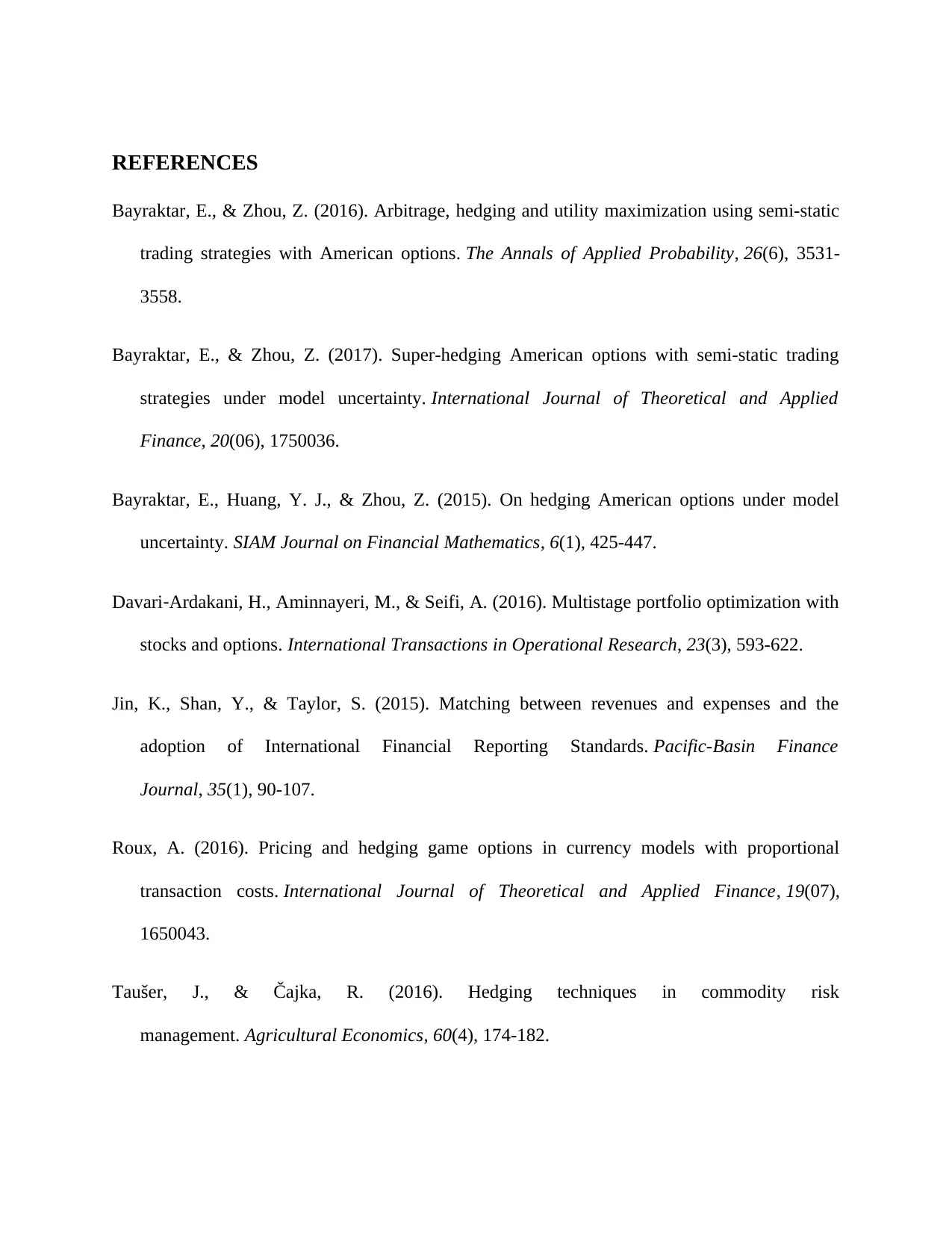
REFERENCES
Bayraktar, E., & Zhou, Z. (2016). Arbitrage, hedging and utility maximization using semi-static
trading strategies with American options. The Annals of Applied Probability, 26(6), 3531-
3558.
Bayraktar, E., & Zhou, Z. (2017). Super-hedging American options with semi-static trading
strategies under model uncertainty. International Journal of Theoretical and Applied
Finance, 20(06), 1750036.
Bayraktar, E., Huang, Y. J., & Zhou, Z. (2015). On hedging American options under model
uncertainty. SIAM Journal on Financial Mathematics, 6(1), 425-447.
Davari‐Ardakani, H., Aminnayeri, M., & Seifi, A. (2016). Multistage portfolio optimization with
stocks and options. International Transactions in Operational Research, 23(3), 593-622.
Jin, K., Shan, Y., & Taylor, S. (2015). Matching between revenues and expenses and the
adoption of International Financial Reporting Standards. Pacific-Basin Finance
Journal, 35(1), 90-107.
Roux, A. (2016). Pricing and hedging game options in currency models with proportional
transaction costs. International Journal of Theoretical and Applied Finance, 19(07),
1650043.
Taušer, J., & Čajka, R. (2016). Hedging techniques in commodity risk
management. Agricultural Economics, 60(4), 174-182.
Bayraktar, E., & Zhou, Z. (2016). Arbitrage, hedging and utility maximization using semi-static
trading strategies with American options. The Annals of Applied Probability, 26(6), 3531-
3558.
Bayraktar, E., & Zhou, Z. (2017). Super-hedging American options with semi-static trading
strategies under model uncertainty. International Journal of Theoretical and Applied
Finance, 20(06), 1750036.
Bayraktar, E., Huang, Y. J., & Zhou, Z. (2015). On hedging American options under model
uncertainty. SIAM Journal on Financial Mathematics, 6(1), 425-447.
Davari‐Ardakani, H., Aminnayeri, M., & Seifi, A. (2016). Multistage portfolio optimization with
stocks and options. International Transactions in Operational Research, 23(3), 593-622.
Jin, K., Shan, Y., & Taylor, S. (2015). Matching between revenues and expenses and the
adoption of International Financial Reporting Standards. Pacific-Basin Finance
Journal, 35(1), 90-107.
Roux, A. (2016). Pricing and hedging game options in currency models with proportional
transaction costs. International Journal of Theoretical and Applied Finance, 19(07),
1650043.
Taušer, J., & Čajka, R. (2016). Hedging techniques in commodity risk
management. Agricultural Economics, 60(4), 174-182.
Paraphrase This Document
Need a fresh take? Get an instant paraphrase of this document with our AI Paraphraser
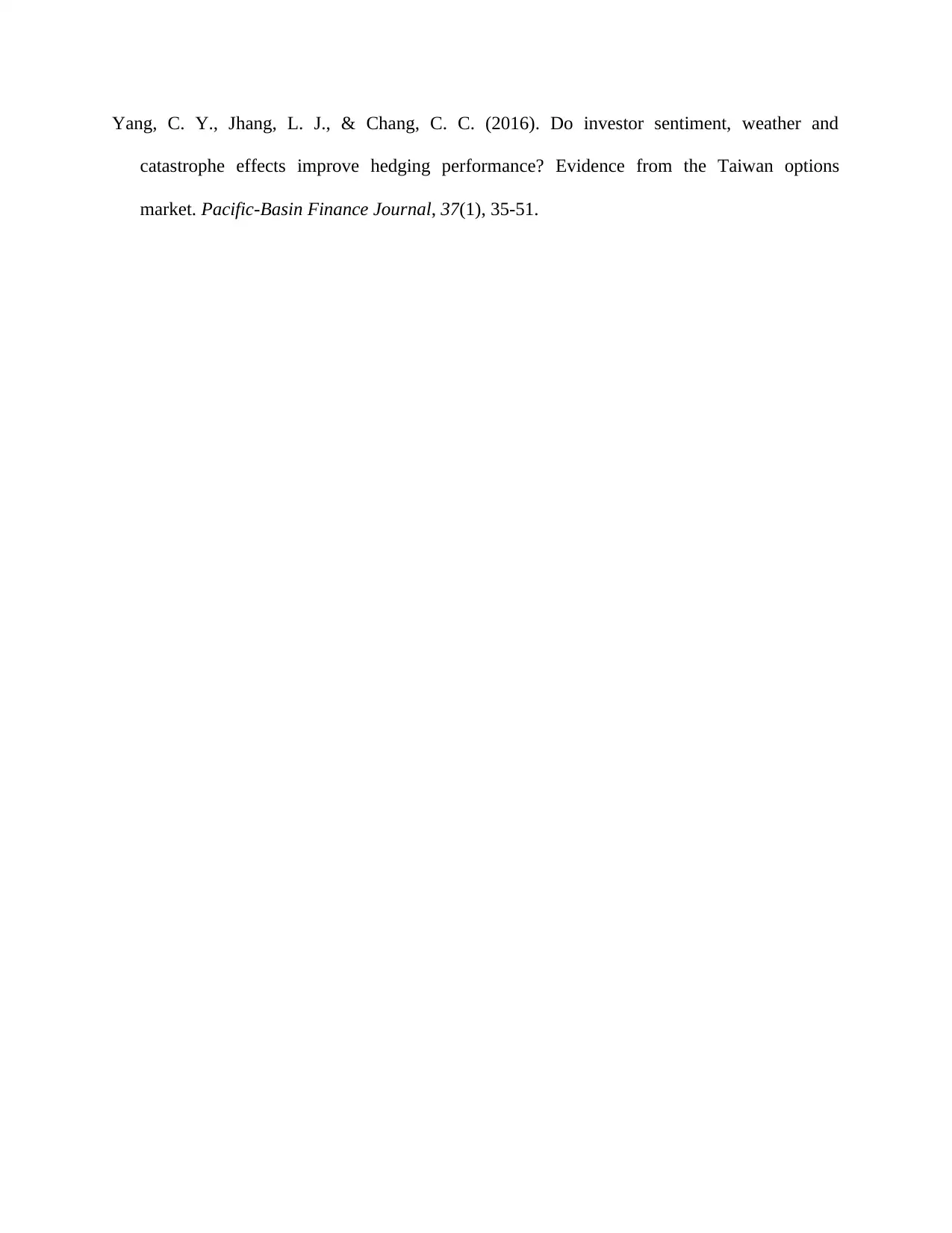
Yang, C. Y., Jhang, L. J., & Chang, C. C. (2016). Do investor sentiment, weather and
catastrophe effects improve hedging performance? Evidence from the Taiwan options
market. Pacific-Basin Finance Journal, 37(1), 35-51.
catastrophe effects improve hedging performance? Evidence from the Taiwan options
market. Pacific-Basin Finance Journal, 37(1), 35-51.
1 out of 8
Related Documents
Your All-in-One AI-Powered Toolkit for Academic Success.
+13062052269
info@desklib.com
Available 24*7 on WhatsApp / Email
![[object Object]](/_next/static/media/star-bottom.7253800d.svg)
Unlock your academic potential
Copyright © 2020–2025 A2Z Services. All Rights Reserved. Developed and managed by ZUCOL.





